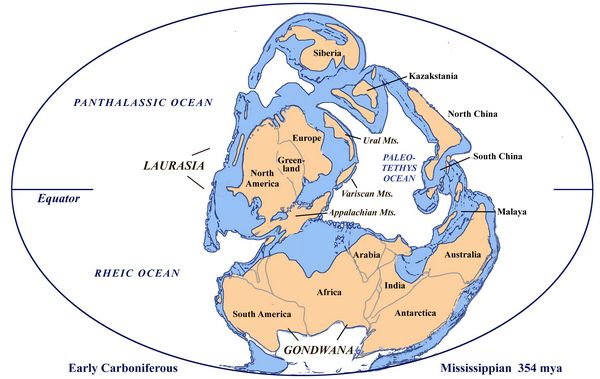Athena Review Image Archive ™
Early Mississippian globe (354 mya)

Early Mississippian globe at ca. 354 mya (map: Athena Review)
The Mississippian period, named for marine limestone rock exposures found in the Mississippi valley, lasted from 359-328 million years ago. In North America, the Mississippian limestone beds and the subsequent Pennsylvanian period (328-298 mya), with its extensive coal deposits, have been treated as separate geological periods. In Europe, the equivalant periods of the Mississippian and Pennsylvanian show a more continuous sequence of lowland continental deposits, and are grouped together as subdivisions of the Carboniferous Period.
During the Mississippian period in North America, plate tectonics and orogeny (collision of continental plates) created the Appalachian Mountains. It was a relatively warm period with an expansion of ferns and coniferous forests, whose legacy included vast coal fields and petroleum deposits.
The Mississippian period saw a radiation of land vertebrates, with a great diversification of amphibians, including many large carnivores as well as plant eaters, and the first appearance of Reptilomorphs, or reptile-like amphibians.
In
the Carboniferous Period of the Eastern Hemisphere, in northern regions
most of the land areas were transgressed by shallow seas,
resulting in extensive carbonate deposits now turned into marine
imestones. Only higher areas such as the Fennoscandian and
Laurentian Shields remained above sea level, surrounded by river delta
systems and lagoons.
References
Clack, Jennifer 2012. Gaining Ground
.Copyright © 1996-2020 Rust Family Foundation (All Rights Reserved).